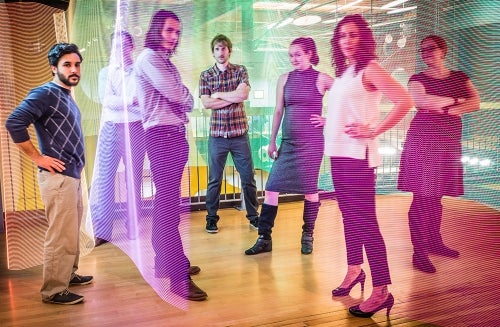
UN Year of Light: Waterloo grad students create light exhibit
THEMUSEUM in downtown Kitchener is hosting LIGHT Illuminated, an exhibit with activities that include a race against light and laser maze

THEMUSEUM in downtown Kitchener is hosting LIGHT Illuminated, an exhibit with activities that include a race against light and laser maze
By Jodi Szimanski Institute for Quantum Computing
Ian Andrews, Kent Fisher, Jean-Philippe MacLean, Michael Mazurek, Aimee Gunther, Angela Olano, and Sarah Kaiser at the opening of the exhibition. Photo credit: Brent Wettlaufer/THEMUSEUM
LIGHT Illuminated, an exhibit created by the University of Waterloo Student Chapter of the Optical Society, is open to visitors now with activities that range from walking through a Mission: Impossible-style laser maze to creating a glow-in-the-dark doodle in an ultraviolet room.
Graduate students from the University of Waterloo Institute for Quantum Computing (IQC) and the Department of Physics and Astronomy created and curated the exhibit to share their knowledge and celebrate the United Nations International Year of Light and Light-Based Technologies.
“Seeing our students share their passion and creativity with our community is wonderful. I’m so proud that they not only represent world-class scientific talent, but that they choose to share their knowledge through new and diverse projects,” said Raymond Laflamme, executive director of IQC. “It’s wonderful to see this kind of meaningful outreach into our community, a community that so strongly supports us.”
Upon entering the exhibit, visitors can experience how light acts as a wave by using a rope. They can then try to race against the speed of light and compare their time with the world’s fastest animals.
The exhibit features interactive optics and physics lessons including displays that feature polarization, the electromagnetic spectrum, ultraviolet light, colour mixing and infrared cameras where guests skip rope and see their bodies heat up via a heat-sensing camera. Other exhibits show how light bends and how refraction works in the eye and through glass.
The highlight of the exhibit for most visitors is the laser maze. Visitors enter a pitch black room and attempt to maneuver through the room without breaking any of the beams in true spy style.
Additional displays also showcase how local companies use light in their technologies. Projection mapping technology from Christie Digital shows how imaging technology can add colour to a three-dimensional white model. Visitors can also get a glimpse under their skin with the Christie Digital VeinViewer that maps blood vessels in the arm in real time.
According to the UN, 2015 is a year to raise “global awareness about how light-based technologies promote sustainable development and provide solutions to global challenges in energy, education, agriculture and health. The UN highlights how light plays such a vital role around the world and is such an important areas of science in the 21st century.
Light-based technologies have revolutionized medicine, opened up international communication via the Internet and continue to be central to linking cultural, economic and political aspects of the global society. Applications of light include:
Learn more by exploring the LIGHT Illuminated exhibit at THEMUSEUM, on display until March 28, 2016. Local partners such as IQC, the University of Waterloo, Waterloo’s Knowledge Integration program, Christie Digital, Teledyne DALSA, COM DEV and FiberTech Optica supported the exhibitions, as did the American Physical Society.

Read more
Serapis Labs develops prototype for a testing kit that is simple enough for anyone to use

Read more
Leaders tell Waterloo Innovation Summit to fund basic research to commercialize unexpected outcomes

Read more
Waterloo Philosophy Professor Heather Douglas has been named a Fellow of the American Association for the Advancement of Science (AAAS)
The University of Waterloo acknowledges that much of our work takes place on the traditional territory of the Neutral, Anishinaabeg, and Haudenosaunee peoples. Our main campus is situated on the Haldimand Tract, the land granted to the Six Nations that includes six miles on each side of the Grand River. Our active work toward reconciliation takes place across our campuses through research, learning, teaching, and community building, and is co-ordinated within the Office of Indigenous Relations.